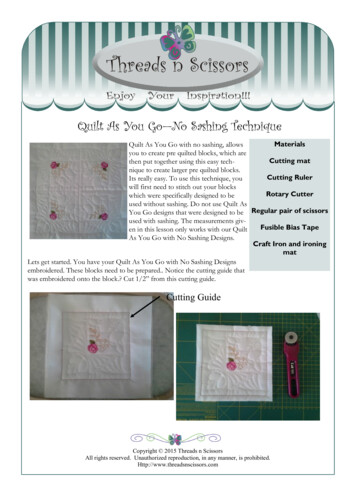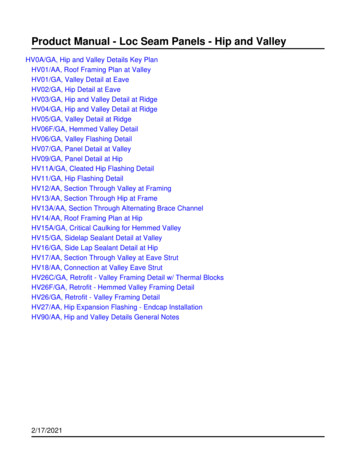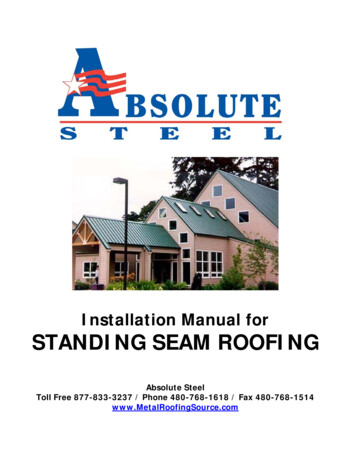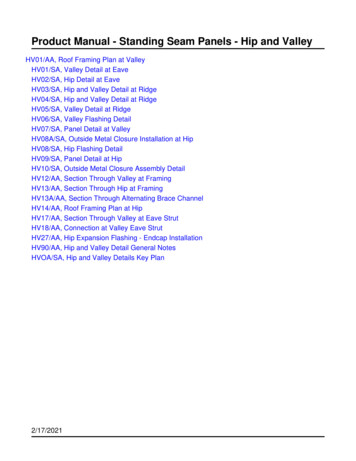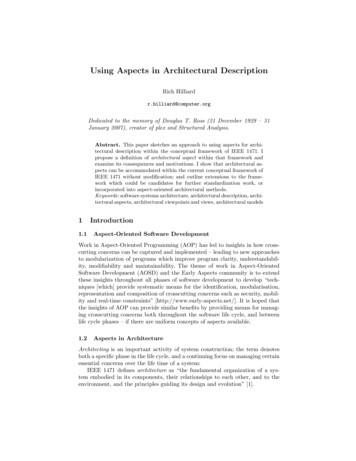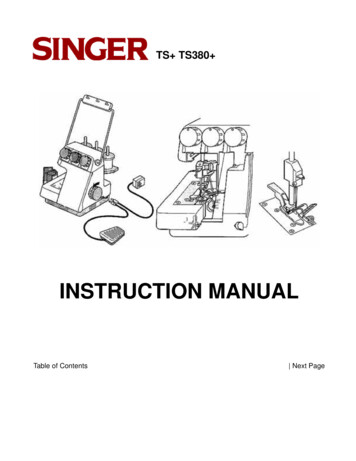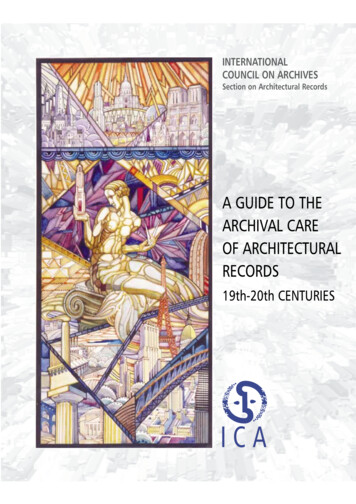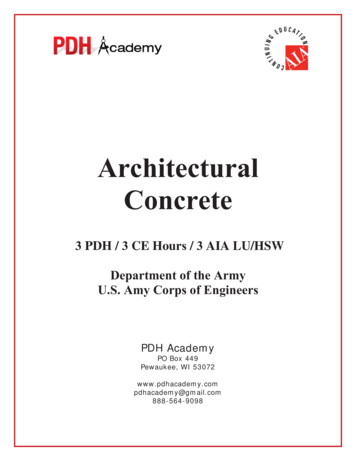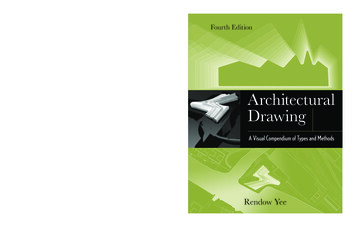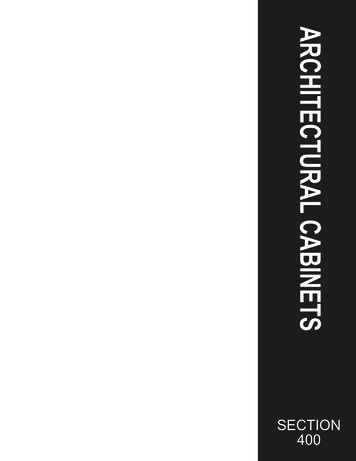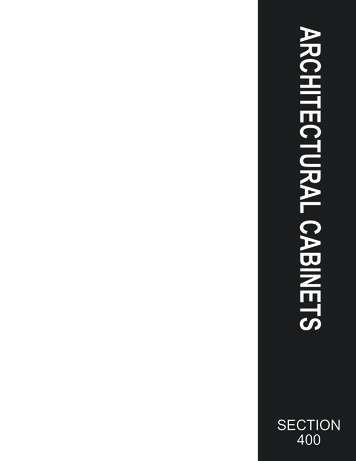
Transcription
Standing Seam Install GuideArchitectural: Image II, Vertical Seam, Snap-Lock 150Standing Seam - Architectural Install GuidePage 1 of 38800-728-4010bestbuymetals.com
Table of Contents1.2.3.4.5.6.General Information . 4a. Noticeb. Applicabilityc. Safetyd. Material Handling and Storagee. Packagingf. Unloadingg. Handlingh. StorageWorking With Metal . 6a. Cutting and Drillingb. Expansion and Contractionc. Oil-Canningd. Dissimilar Metalse. Chemically Treated Lumberf. GraphiteDesign Information . 8a. Planningb. Slopec. Substrated. Underlaymente. Insulation, Vapor Retarders, & Air Barriersf. VentilationProduct Information 10a. Panel Description and Optionsb. Panel Fastenersc. Sealantsd. Metal Flashings and TrimInstallation Instructions . 13a. Tools and Accessoriesb. Underlayment Installationc. Panel Installationd. Installing Trim and Flashing DetailsRoof Protection and Repair . 19a. Roof Protection During Installationb. Roof Protection After Installationc. Finishes and Touchupd. Repairs to RoofAppendixI.II.III.Accessories Guide 20-21Flashings and Trim . 22-23Installation Detailsa. Details Cover and Panel Fastening .24b. Eave Detail . . . 25d. Eave Detail (flush style) . 26e. Eave Detail (with gutter) . 26f. Gable Detail (extended drip edge style) . 27g. Gable Detail (box style with zee closure) 27h. Valley Detail . 28i. Ridge and Hip Detail . 28j. Vented Ridge Detail (with vent material) . 29k. Vented Ridge Detail (with perforated zee closure) 29Standing Seam - Architectural Install GuidePage 2 of 38
l.m.n.o.p.q.r.s.Peak Detail . 30Endwall (Highwall) Detail .30Low Wall (Chimney, Skylight) Detail 31Sidewall Detail .31Slope Transition Detail .32Gambrel Detail 32Pipe Penetration Detail . 33Curb Detail Series . 34 thru 36Standing Seam - Architectural Install GuidePage 3 of 38
1. GENERAL INFORMATIONa. Notice· This guide contains general design guidance and suggested application instructions and details forproper application of Best Buy Metals (BBM) metal roofing products. It is theresponsibility of the installer to verify conformance of installation to applicable building code, safety,and insurance requirements. BBM assumes no responsibility for any problems which might arise asa result of improper installation or any personal injury or property damage that may occur with theproduct’s use.· Statements in this guide are provided in good faith with the expectation that a design professional beconsulted prior to any job decisions being made. Projects should be engineered to conform toapplicable building codes, regulations, and accepted industry practices.· Installing a metal roofing system is a skilled craft that requires considerable trade knowledge andexperience. It is not the intent of this guide or BBM to train individuals in the skills required toproperly install a metal roof system or to convey all the necessary trade or general constructionknowledge required to properly and safely perform work on a roof. BBM does not guarantee and isnot liable for the qualifications of the installer. For additional information and resources pertaining to the installation of metal roofing materials,the following sources are recommended:a. SMACNA (Sheet Metal and Air Conditioning Contractors’ National Association)Architectural Sheet Metal Manual. (www.smacna.org)b. The NRCA (National Roofing Contractors Association) Roofing Manual: MetalPanel and SPF Roof Systems. (www.nrca.net)· It is the responsibility of the BBM customer, installer, and/or designer to ensure that the details meetparticular building requirements to assure weathertightness.· This guide is intended to be used in conjunction with engineered shop drawings specific to anindividual project (if applicable). Custom roof conditions and detailing are covered by engineeredshop drawings for the specific project. In the event of a conflict between this guide and theengineered shop drawings, the engineered shop drawings will take precedence.· Contents in this guide are subject to change and revision without notice. Please contact BBM toverify that this manual is the most current copy available.b. Applicability· The metal roof system as described within this manual is classified as a standing seam metal roofpanel. Panels are mechanically attached with hidden fasteners to a continuous solid substrate with anunderlayment. The detailing and attachment methods described within this manual best reflect “steepsloped” sheet metal joinery considered a craft or trade. This type of detailing, with clean lines andhidden fasteners is desired for high performance in combination with visual appeal.c. Safety· There are potential hazards associated with the installation of a metal roof system. An experiencedinstaller should recognize these hazards, be qualified to work with them, and be capable of providingsafe work practices and equipment that minimize the risks of injury. Following are some warningsthat should be considered when working with metal roofing. These may not cover all hazards, so theinstaller should take proper precaution to be prepared for working on roofs and handling metal. OSHA (Occupational Safety and Health Administration): Obey OSHA regulations, particularlythose related to roof construction, such as Title 29 Code of Federal, 1926 Subpart M, FallProtection. For copies of OSHA regulations visit www.osha.gov . Use fall protection and all appropriate safety equipment as agencies or jobsites require. Avoid working on surfaces that are covered with moisture, frost, snow/ice, dust or othersubstance that may cause unsure footing. Never walk on substrate, underlayment, or panels that are not properly secured in place. Take caution when handling sheet metal panels and flashings. Edges can be sharp and cancause severe cuts. Wear heavy gloves for protection. Wear eye protection when cutting and drilling to prevent eye injury from flying metal fragments. Take caution when handling panels and trim in strong winds. Wind pressure can cause loss ofbalance and endanger workers with being struck by flying objects.Standing Seam - Architectural Install GuidePage 4 of 38
Materials loaded to rooftop should always be secured to substrate to prevent them from slidingdown roof slope or being dislodged by high winds. Maintain safe distances from electric power lines when handling metal panels and trims sincethey are excellent conductors.d. Material Handling and Storage· Receiving a delivery When receiving materials, check the condition of the product and review the shipment against theshipping ticket to ensure all items are accounted for. If damages or shortages are discovered, itshould be noted on the shipping copy at the time of delivery. BBM will not be responsible forshortages or damages unless they are noted on the shipping ticket. In addition, all damages andshortages should be reported to BBM with 48 hours from time of shipment.e. Packaging· Panels are shipped in bundled units of approximately thirty to fifty panels. Panels are stacked on edgeand are packaged with wood blocking in an open crate design. Space is provided under crates foraccess by forks of lift truck or inserting lifting slings/straps when offloading by crane.(Figure 1).· For LTL or special overseas shipments, panels are packaged in completely enclosed wooden cratesto provide optimum protection. Additional charges will apply. Contact BBM for further information onthis non-standard packaging.Figure 1: Packaging for panels (open crate and completely enclosed crate options)f.Unloading· Unless a moffett or boom delivery truck is available, it is the responsibility of the installer to unloadmaterials from the delivery truck. The installer shall be responsible for providing suitable equipmentand means for unloading materials safely and without damaging product.· When handling crates and bundles always support unit from underneath. Position forks or slings in amanner that maintains proper balance.· Lift trucks with forks minimum 5 feet apart can be used for lifting bundles up to 25 feet long (Figure 2).Reasonable care should be taken while unloading to prevent damage from shocks or suddenmovements.· Bundles over 25 feet in length should be lifted with nylon slings and a spreader bar. Never use chain,cable, or rope to lift bundles. As a general rule, no more than one third or maximum 15 feet of panelshould be left unsupported.Figure 2: Lift truck with panel bundle. Crane with spreader bar and panel bundle.Standing Seam - Architectural Install GuidePage 5 of 38
g. Handling· Individual panels should be carried on edge by hand and supported evenly with a maximum spacingof 10 to 12 feet (Figure 3).· Handlers should maintain uniform movements while transporting panels to prevent bending ortwisting that will cause permanent damage.Figure 3: Carrying panels. Maintain maximum distance of 10-12 feet between holdersh. Storage· Store all materials in a protected area away from standing water. Panels and trim should be coveredto protect from moisture, debris, and long term exposure to sunlight. Keep bundles elevated abovethe ground to allow air to circulate freely. Elevate one end of bundles to prevent moisture fromresting on surfaces.· Exposure to dirt and moisture during storage can cause damage or staining of finish and materialsurfaces. Prolonged storage of panels and trim in bundles is not recommended. If conditions do notallow for immediate erection, extra care should be taken to protect materials from moisture. If panelsand trim should contain moisture they should be dried and re-stacked.· Panels and trim may have strippable polyfilm applied to surfaces for protection during fabrication,packaging, and transit. This film must be removed immediately prior to installation. Care should betaken to protect film from long term exposure to moisture and direct sunlight. Extended exposure tosunlight will cause polyfilm to be permanently adhered to panel surface.2. WORKING WITH METALa. Cutting and Drilling· DO NOT cut panels with saws or grinders. Only use appropriate sheet metal cutting tools designedto “shear cut” components with clean, burr free edges. Abrasive cutting mechanisms will damageGalvalume substrate and paint finishes and promote rusting of the steel components.· Metal debris from cutting and drilling processes should be removed during installation. If not removedmetal filings will red rust on the surfaces where they were deposited. Rusting of the metal filings maycause stain or discoloration on the surface of the panels and trim. Hot shavings should be preventedfrom coming into contact with painted surfaces. They may become embedded into the paintedsurface.b. Expansion and Contraction· Metal panels and trim are exposed to daily cycles of temperature changes from ambient temperaturesand exposure to sunlight (Table 1). Temperature fluctuations cause metal components to expandand contact. Allowances should be made for the expansion and contraction of panels and trim.Restriction of expansion and contraction can produce “oil-canning” in panel/trim surfaces and causefailures at fastener locations.Standing Seam - Architectural Install GuidePage 6 of 38
Thermal Expansion/Contraction forSteel Roof Panels at 180 F DifferentialDistance fromfixed pointNom. Expansion10 feet1/8" (0.145")20 feet5/16" (0.289")30 feet7/16" (0.434")40 feet9/16" (0.579")50 feet3/4" (0.724")60 feet7/8" (0.868")70 feet1" (1.013")80 feet1-3/16" (1.158")90 feet1-5/16" (1.302")100 feet1-7/16" (1.447")*Coefficient of expansion 0.0000067 in/in/F Table 1: Thermal Expansion/Contraction of Steel Panels·Metal flashing and trim should be installed with sealed end laps that allow for expansion andcontraction.· Panels should be installed with a “fixed” end and a “free” end. This manner allows for expansion andcontraction to be controlled uniformly at one end of the roof. This manual follows the “architectural” or“steep slope” installation method which applies a point of fixity at the high end of the panels (i.e. ridge,hip, high wall, and peak). Expansion and contraction is accommodated at the low end of panels (i.e.eaves and valleys).c. Oil-Canning· The perceived waviness in flat metal commonly known as “oil-canning” is an inherent part of lightgauge cold formed metal panels and trim. BBM will not accept “oil-canning” as a cause for rejection.· Oil-canning can be minimized by means of heavier gauges, narrower panel widths and panelstriations.· Substructure must be even plane to within ¼” in 20 feet from eave to ridge to reduce panel distortion.d. Dissimilar Metals· DO NOT allow the steel roofing system to come into direct contact with dissimilar metals such ascopper or brass. Corrosion caused by contact with dissimilar metals is not covered by warranties.· DO NOT install steel roofing system in a location in which it will come directly in contact with moisturerun-off from copper materials. Moisture run-off from copper materials will prematurely corrode steelcomponents.e. Chemically Treated lumber· Chemically treated lumber can be highly corrosive to metal roofing components. Care should betaken to separate metal components from direct contact with chemically treated wood. Corrosioncaused by treated lumber is not covered by warranties.· Use only stainless steel or ceramic coated fasteners for attachment to chemically treated wood.f. Graphite· Avoid the use of graphite pencils when marking unpainted Galvalume steel components to avoidpremature corrosion of material.Standing Seam - Architectural Install GuidePage 7 of 38
3. DESIGN INFORMATIONa. Planning· It should be noted that this guide does not cover all conditions or situations for the design andapplicability of BBM products for every project or installation.· BBM recommends that a design professional be consulted to ensure proper design and application.Additional design assistance can be provided by contacting BBM.b. Slope: Image II and Snap-Lock 150 panels are recommended for roof slopes of 3 inches in 12 and greater.Vertical Seam panels are recommended for roof slopes of 1 inches in 12 and greater over solid decking or 3inches in 12 and greater over open framing.· Roof design should be free of any areas that pond water or impede water flow.· Consult BBM for applications requiring slope less than specified.c. Substrate: Image II and Snap-Lock 150 require a continuous solid substrate. Vertical Seam can be installedover a solid substrate or open framing.· The following is a list of acceptable substrates Minimum 7/16” APA rated OSB or minimum 15/32” APA rated plywood Nominal 1” or greater tongue and groove wood planks Minimum 7/16” APA rated OSB or minimum 15/32” APA rated plywood over rigid insulation overminimum 22 gauge steel decking· Substrate Preparation Substrate must be structurally sound and must meet the minimum requirements for the systemperformance (i.e. structural loading and wind uplift resistance). Deck must not be out of plane more than ¼” in 20 feet from eave to ridge. Surface of substrate must be smooth, dry, and free of debris which might damage or distortpanels.d. Underlayment· All installations of panels over a solid substrate require the use of continuous layer ofunderlayment applied directly under the roof panels. For slopes 3:12 and greater BBM recommends application of Synthetic underlayment or equal.Asphalt saturated felt paper (meeting ASTM D 226 Type II #30) may be used in lieu ofsynthetic underlayment but does not offer the strength and protection as synthetic underlayment. Self adhered membrane underlayment may be required for certain vulnerable detail conditions,slopes less than 3:12, or certain deck assemblies. Self-adhered underlayment should have thefollowing minimum properties:a. Smooth surfaced (non-granulated)b. High temperature resistance (minimum 240º F)c. Minimum thickness of 40 mild. Approved by the underlayment manufacturer for application under metal roofinge. Insulation, Vapor retarders, & Air Barriers· The necessity and location of insulation, a vapor retarder, and/or an air barrier is the responsibility ofthe building owner or designer. BBM does not accept responsibility for damage as a result ofimproper application of these items.Standing Seam - Architectural Install GuidePage 8 of 38
f.Ventilation· The necessity of venting the roof structure is the responsibility of the building owner or designer.BBM does not accept the responsibility for issues as a result of improperly vented roof systems.· For single-family residential applications, FHA guidelines recommend the 1/300 rule: 1 square foot ofnet free vent area for every 300 square feet of attic floor space. Net free vent area includes exhaustand intake venting. It is recommended to use a ratio of 60% intake venting and 40% for exhaustventing. Some building codes may require the 1/150 rule Always check with local building code forexact requirements.· No attic vents should be installed between the intake and exhaust vents. This approach will “shortcircuit” the vent path between intake and exhaust vents leaving attic portions unvented.· Ridge ventilation is the ideal method for venting a metal roof system.Figure 4: Proper venting methodStanding Seam - Architectural Install GuidePage 9 of 38
4. PRODUCT INFORMATIONa. Image II Panel Description and Options16"1"Striations (Standard)···Rib profile: 1 inch tall integral “snap” lock design with fastening flangeWidth: Standard panel width is 16 inches. Other widths available by location.Profile: Standard panel profile is “striated”. Flat Pan (Smooth Profile) is also available. Somelocations offer 2 pencil rib, 2 mesa rib, 2 minor rib, or 4 minor rib profiles. The striated profile optionprovides the best means for reducing the visibility of any potential oil-canning.Striations (Standard)Flat Pan (Optional)2 Pencil Ribs (Check Availability)2 Mesa Ribs (Check Availability)2 Minor Ribs (Check Availability)4 Minor Ribs (Check Availability)·Panel lengths: Standard lengths available from 3 to 48 feet. Longer lengths are available. ContactBBM for additional information regarding panel lengths greater than 48 feet.· Materials: Available in 26 and 24 gauge AZ-50 Galvalume coated steel and 0.032” aluminum.· Finishes: Available in unpainted Galvalume (with clear acrylic coating) or factory applied coloredfinishes. Siliconized Modified Polyester finish is available with 26 gauge option. Kynar 500Flouropolymer finish is available in 24 gauge steel and 0.032” aluminum options. Refer to colorselection charts for finish choices.b. Panel Fasteners: Fasteners are applied through the fastening flange located on the male leg of panel. Formost wood substrates the recommended fastener is a #10-12 x 1 inch long pancake head wood screw.Fasteners for wood should be of sufficient length to penetrate the substrate by ¼ inch or be imbedded intosheathing by ¾ inch.Standing Seam - Architectural Install GuidePage 10 of 38
4. PRODUCT INFORMATIONa. Vertical Seam Panel Description and Options12”, 16", or 18”1.75"Factory Applied SealantStriations (Standard)···Rib profile: 1.75 inch tall integral “snap” lock design with hidden clipsWidth: Standard panel widths are 12, 16, and 18 inches.Profile: Standard panel profile is “striated”. Flat Pan (Smooth Profile) is also available.Striations (Standard)·Flat Pan (Optional)Panel lengths: Standard lengths available from 5 to 45 feet. Longer lengths are available. ContactBBM for additional information regarding panel lengths greater than 45 feet.· Materials: Available in 26 and 24 gauge AZ-50 Galvalume coated steel and 0.032” aluminum.· Finishes: Available in unpainted Galvalume (with clear acrylic coating) or factory applied coloredfinishes. Siliconized Modified Polyester finish is available with 26 gauge option. Refer to colorselection charts for finish choices. Kynar 500 Flouropolymer finish is available in 24 gauge steel and0.032” aluminum options.b. Panel Fasteners: Clips lock over the male leg of panel and fasteners are applied into the holes located onclips. For most wood substrates the recommended fastener is a #10-12 x 1 inch long pancake head woodscrew. Fasteners for wood should be of sufficient length to penetrate the substrate by ¼ inch or be imbeddedinto sheathing by ¾ inch.Standing Seam - Architectural Install GuidePage 11 of 38
4. PRODUCT INFORMATIONa. Snap-Lock 150 Panel Description and Options16"1.5"Striations (Standard)··Rib profile: 1.5 inch tall integral “snap” lock design with hidden clipsWidth: Standard panel width is 16 inches. Other widths available by location.Profile: Standard panel profile is “striated”. Flat Pan (Smooth Profile) is also available. Somelocations offer 2 pencil rib, 2 mesa rib, 2 minor rib, or 4 minor rib profiles. The striated profile optionprovides the best means for reducing the visibility of any potential oil-canning.Striations (Standard)Flat Pan (Optional)2 Pencil Ribs (Check Availability)2 Mesa Ribs (Check Availability)·Panel lengths: Standard lengths available from 3 to 48 feet. Longer lengths are available. ContactBBM for additional information regarding panel lengths greater than 48 feet.· Materials: Available in 26 and 24 gauge AZ-50 Galvalume coated steel and 0.032” aluminum.· Finishes: Available in unpainted Galvalume (with clear acrylic coating) or factory applied coloredfinishes. Siliconized Modified Polyester finish is available with 26 gauge option. Refer to colorselection charts for finish choices. Kynar 500 Flouropolymer finish is available in 24 gauge steel and0.032” aluminum options.b. Panel Fasteners: Clips lock over the male leg of panel and fasteners are applied into the holes located onclips. For most wood substrates the recommended fastener is a #10-12 x 1 inch long pancake head woodscrew. Fasteners for wood should be of sufficient length to penetrate the substrate by ¼ inch or be imbeddedinto sheathing by ¾ inch.Standing Seam - Architectural Install GuidePage 12 of 38
c.Sealants: Sealant is a necessary component to prevent water from infiltrating thru the metal roofing system. Itis applied to joints, laps, intersections, and perimeter edges of panels and flashings. It is also applied to lapsand joints of gutters and downspouts to control water containment to ground level.· Tape Sealant: Tape sealant is a non-drying sealant with excellent physical and weatheringcharacteristics. It has a high dimensional stability which makes it ideal for use where the matingsurfaces are in compression such as between zee closure flashing and roof panels. Tape sealantshould NOT be used as a surface sealant or where the sealant is not compressed between the twomating surfaces. Tape sealant should NOT be installed where exposed to direct sunlight. Material: Butyl polyiso butylene base extruded compound· Tube Sealants: Tube sealants can be used in virtually all locations where sealant is required. It canbe used between mating surfaces or applied as an exposed surface sealant. For best results, toolsealant into corners or mating surfaces to ensure continuous adhesion to material surfaces andeliminate voids. Packaging: Tube sealants are available in / 10 oz. cartridges and have an approximatecoverage rate of 25 lineal feet for ¼ inch bead diameter.d. Metal Flashings and Trim: Flashings and trim are brake-formed components applied at roof perimeters,intersections, transitions, and junctions to prevent water infiltration. They are typically provided in matchinggauges and finishes to the roof panels but can be contrasting materials and colors.5. INSTALLATION INSTRUCTIONSa. Tools and Accessories· Recommended tools for installation Sheet metal snips (long nose, left hand, right hand): for general cutting of trims and panels Locking style C clamps: for holding panels and trims in position during cutting and drilling Hand seamers (duckbill folder): for bending sheet metal tabs and hems Panel hemming tool: for forming hem on panel ends at eaves and valleys Pop rivet tool: for installing 1/8” diameter rivets in trims, flashing, and guttering Hammer Chalk line Tape measure Electric screw gun Drill bits (1/8” diameter) Hole Punch TurboShear HD attachment: for long cuts in trims and panels Marking pens: for marking cuts in sheet metal components Utility knife Caulk gunb. Underlayment Installation:· Underlayment should be installed continuous over entire substrate· Roof deck must be clean and free from any moisture, ice, dust, loose nails, protrusions, voids, andother debris· Start at lowest portion of roof. Apply with printed side up. Extend underlayment over roof edges(eaves and rakes) minimum 1-1/2”. Install full course centered along valleys.· Extend underlayment minimum 6” up vertical termination details (i.e. sidewall and highwalls).Standing Seam - Architectural Install GuidePage 13 of 38
·c.Synthetic underlayment is mechanically fastened to substrate. Use only electroplated, galvanized, orcoated fasteners. Use of “common steel” (uncoated) roofing nails may result in rusting that canspread to the underside of metal roof panels and flashings. DO NOT use staples for application ofunderlayment.· Self-adhered membrane underlayment to be applied with release paper towards roof surface.Remove release paper diagonally from bottom of roll while applying heavy hand pressure to topsurface. Refer to manufacturer’s requirements for minimum application temperatures and instructionsfor cold weather installation.· Underlayment left exposed to elements for a period beyond the manufacturer’s recommendedexposure duration should be completely replaced or covered with new.Panel Installation· For best performance, panels should extend full length from low point (eave and valley conditions) tohigh point (hip, ridge, peak, and highwall conditions). Field splicing of panels is possible but notrecommended. Splicing may be considered when panel runs exceed maximum shippable lengths.Contact BBM for additional information on field splicing and maximum shipping lengths.· Panels should be hemmed around drip edges and cleats at lowest points to allow for expansion andcontraction. Panel hemming is performed in field by installer. Refer to Table 4 “Thermal GapInstallation Chart” and Figure 6 for hem lengths and gap settings.Thermal Gap Installation Chart for Steel Roof Panels at 180º F DifferentialDistance from fixed pointMaterial Temperature During InstallationHot ( 100º F)Warm (100º to 50º F)Cold ( 50º F)10 feet1/8" (0.145")1/16" (0.072")020 feet5/16" (0.289")1/8" (0.145")030 feet7/16" (0.434")3/16" (0.217")1/8" (0.125")40 feet9/16" (0.579")5/16" (0.289")1/8" (0.125")50 feet3/4" (0.724")3/8" (0.362")3/16" (0.188")60 feet7/8" (0.868")7/16" (0.434")3/16" (0.188")70 feet1" (1.013")1/2" (0.507")1/4" (0.25")80 feet1-3/16" (1.158")9/16" (0.579")1/4" (0.25")90 feet1-5/16" (1.302")5/8" (0.651")3/8" (0.375")100 feet1-7/16" (1.447")3/4" (0.724")3/8" (0.375")*Coefficient of expansion 0.0000067 in/in/F Table 4: Thermal Gap Installation ChartStanding Seam - Architectural Install GuidePage 14 of 38
Figure 6: Setting Panel Thermal Gap During Installation·Panel hemming: Notch vertical legs back from eave end of panel equal to hem length (nominally 1 inch ormaximum dimension provided by Figure 6). Use panel hemming tool to fold panel end 180 degrees.Figure 7: Panel HemmingFigure 8: Closing Female Rib End (optional)Standing Seam - Architectural Install GuidePage 15 of 38
·Installing Panels The following flashing assemblies must be installed prior to installing panels:a. Eave drip edge (with sub-panel flashings if used)b. Valley flashingc. Gable Trims (sub-panel flashings only) Panel installation must begin at an extreme lower left or right position for each roof plane to becovered. Installation can proceed in only one direction across plane of roof. Install first panel. Hook hemmed end onto eave drip edge or offset cleat. Fasten upper most endof panel to substrate with single fastener into substrate to secure panel in place. Install panel fasteners along fastener flange of male leg of panel at required spacing interval.Refer to Table 2 or 3 for spacing guidelines. It is recommended to install two fasteners togethernear the eave end of the panels to provide additional resistance against wind uplift which can besignificant at roof edges. Install second panel by loosely lapping female leg over male leg. Let lower panel end (eave end)extend off roof edge so panel hem does not interfere with drip edge. With hand pressure, snapdown lower end of panel only so that panel hem is below extended lip of drip edge. Carefullyslide panel up slope to fully engage panel hem around lip of drip edge. Set expansion gap asindicated in Figure 6. Snap down female rib onto male rib with hand pressure starting at eaveand working upslope. CAUTION: Use of hammer or mallet to snap panels together may damagepanel rib or cause panels to dent at fastener locations. Continue to install remaining panels in same manner as above. It is important to check for modularity (dimension across panel width) as panels are installed.Measure across multiple ribs at both ends of panels to verify that panels are installed square.Failure to maintain modularity will result in poor alignment at eave (“saw-tooth affect”) andnoticeable dimension variations al
Metal flashing and trim should be installed with sealed end laps that allow for expansion and contraction. Panels should be installed with a "fixed" end and a "free" end. This manner allows for expansion and contraction to be controlled uniformly at one end of the roof. This manual follows the "architectural" or
